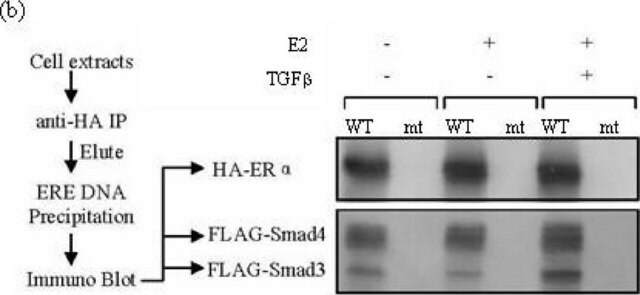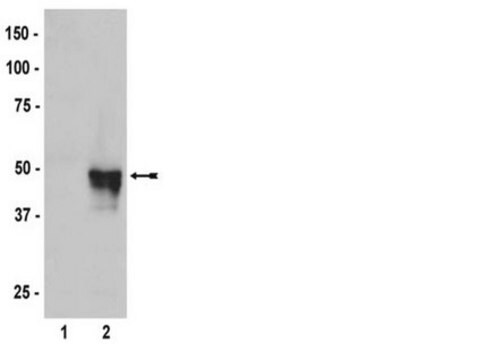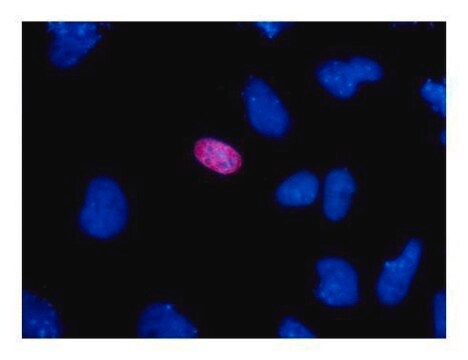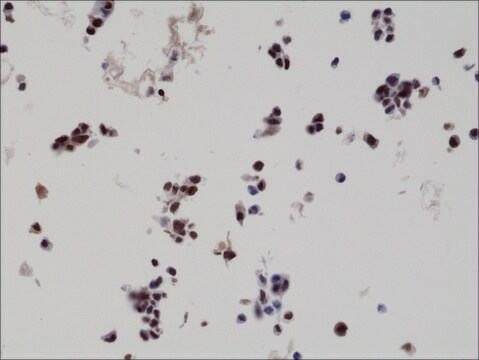04-902
Anti-HA Tag Antibody, clone DW2, rabbit monoclonal
culture supernatant, clone DW2, from rabbit
Sign Into View Organizational & Contract Pricing
All Photos(1)
About This Item
UNSPSC Code:
12352203
eCl@ss:
32160702
NACRES:
NA.43
clone:
DW2, monoclonal
application:
WB
species reactivity:
vertebrates (common species)
technique(s):
western blot: suitable
citations:
17
Recommended Products
biological source
rabbit
Quality Level
antibody form
culture supernatant
antibody product type
primary antibodies
clone
DW2, monoclonal
species reactivity
vertebrates (common species)
technique(s)
western blot: suitable
isotype
IgG
shipped in
dry ice
target post-translational modification
unmodified
General description
Human influenza hemagglutinin (HA) is a surface glycoprotein required for the infectivity of the human virus. The HA tag is derived from the HA molecule that corresponds to amino acids 98-106. It has been extensively used as a general epitope tag in expression vectors. Many recombinant proteins have been engineered to express the HA tag, which does not appear to interfere with the bioactivity or the biodistribution of the recombinant protein. This tag facilitates the detection, isolation, and purification of the proteins.
Specificity
Reactivity with other species has not been confirmed.
Recognizes recombinant proteins containing the HA epitope tag. The apparent molecular weight is related to the tagged protein.
Immunogen
KLH-conjugated, synthetic peptide containing the sequence …CYPYDVPDY… derived from the influenza virus hemaglutinin (HA) protein.
Application
Anti-HA Tag Antibody, clone DW2 is an antibody against HA Tag for use in WB.
Research Category
Epitope Tags & General Use
Epitope Tags & General Use
Research Sub Category
Epitope Tags
Epitope Tags
Western Blot Analysis: A 1:1,000-1:2,000 dilution of this lot detected HA-tagged WNT-1 protein expressed in HEK293 cells.
Quality
Western Blot Analysis
Lysates from non-transfected (lane 1) and HAtagged WNT-1 transfected (lane 2) HEK293 cells were resolved by electrophoresis, transferred to nitrocellulose and probed with anti-HA-Tag, clone DW2 (1:1,000 dilution).
Proteins were visualized using a goat anti-rabbit secondary antibody conjugated to HRP and a chemiluminescence detection system.
Arrow indicates the HA-tagged protein (~49 kDa). The apparent molecular weight is related to the tagged protein.
Lysates from non-transfected (lane 1) and HAtagged WNT-1 transfected (lane 2) HEK293 cells were resolved by electrophoresis, transferred to nitrocellulose and probed with anti-HA-Tag, clone DW2 (1:1,000 dilution).
Proteins were visualized using a goat anti-rabbit secondary antibody conjugated to HRP and a chemiluminescence detection system.
Arrow indicates the HA-tagged protein (~49 kDa). The apparent molecular weight is related to the tagged protein.
Target description
Various
Linkage
Replaces: 05-902
Physical form
Cultured supernatant in 0.05% sodium azide.
Storage and Stability
Stable for 1 year at -20°C from date of shipment. Handling Recommendations: Upon receipt, and prior to removing the cap, centrifuge the vial and gently mix the solution. Aliquot into microcentrifuge tubes and store at -20°C. Avoid repeated freeze/thaw cycles, which may damage IgG and affect product performance.
Analysis Note
Control
HA-tagged WNT-1 protein.
HA-tagged WNT-1 protein.
Disclaimer
Unless otherwise stated in our catalog or other company documentation accompanying the product(s), our products are intended for research use only and are not to be used for any other purpose, which includes but is not limited to, unauthorized commercial uses, in vitro diagnostic uses, ex vivo or in vivo therapeutic uses or any type of consumption or application to humans or animals.
Not finding the right product?
Try our Product Selector Tool.
Storage Class
12 - Non Combustible Liquids
wgk_germany
WGK 1
flash_point_f
Not applicable
flash_point_c
Not applicable
Certificates of Analysis (COA)
Search for Certificates of Analysis (COA) by entering the products Lot/Batch Number. Lot and Batch Numbers can be found on a product’s label following the words ‘Lot’ or ‘Batch’.
Already Own This Product?
Find documentation for the products that you have recently purchased in the Document Library.
Customers Also Viewed
Lei Dai et al.
Nature communications, 7, 11996-11996 (2016-06-30)
SARI, also called as BATF2, belongs to the BATF family and has been implicated in cancer cell growth inhibition. However, the role and mechanism of SARI in tumour angiogenesis are elusive. Here we demonstrate that SARI deficiency facilitates AOM/DSS-induced colonic
Haipeng Fu et al.
Nature communications, 13(1), 3984-3984 (2022-07-10)
TGF-β family proteins including Nodal are known as central regulators of early development in metazoans, yet our understanding of the scope of Nodal signaling's downstream targets and associated physiological mechanisms in specifying developmentally appropriate cell fates is far from complete.
Chia-Yi Yu et al.
Journal of virology, 80(23), 11868-11880 (2006-09-22)
The unfolded protein response (UPR) is a coordinated change in gene expression triggered by perturbations in functions of the endoplasmic reticulum (ER). XBP1, a key transcription factor of the UPR, is activated by an IRE1-mediated splicing event, which results in
Saikat Bhattacharya et al.
Nature communications, 12(1), 6452-6452 (2021-11-10)
The RNA recognition motif (RRM) binds to nucleic acids as well as proteins. More than one such domain is found in the pre-mRNA processing hnRNP proteins. While the mode of RNA recognition by RRMs is known, the molecular basis of
Wen-Chi Su et al.
Journal of virology, 92(4) (2017-11-24)
Virus replication is mediated by interactions between the virus and host. Here, we demonstrate that influenza A virus membrane protein 2 (M2) can be ubiquitinated. The lysine residue at position 78, which is located in the cytoplasmic domain of M2
Our team of scientists has experience in all areas of research including Life Science, Material Science, Chemical Synthesis, Chromatography, Analytical and many others.
Contact Technical Service








